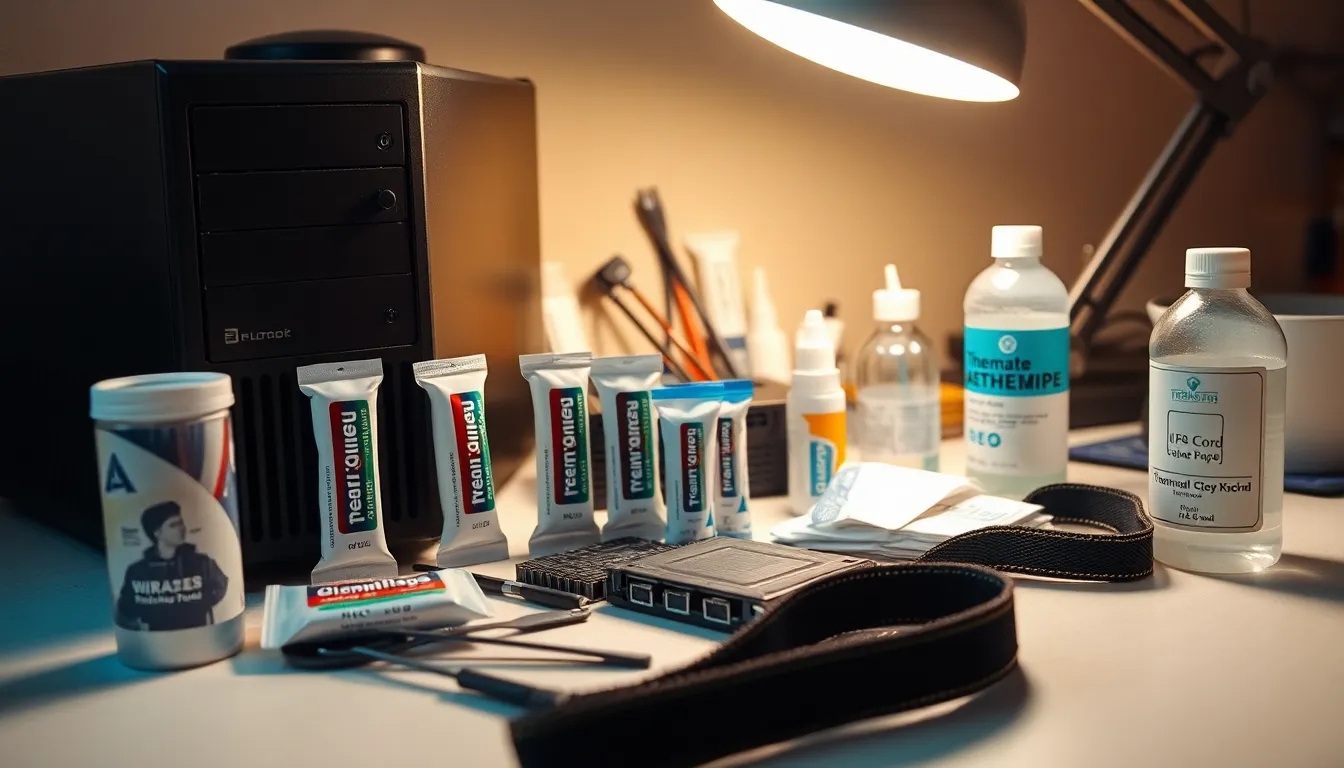When it comes to keeping a computer cool under pressure, thermal paste is the unsung hero. This magical goo bridges the gap between your CPU and cooler, ensuring heat transfer happens like a well-oiled machine. But let’s be real—applying thermal paste isn’t exactly a walk in the park. It’s more like a high-stakes game of “Will it blend?”
Table of Contents
ToggleUnderstanding Thermal Paste Application
Thermal paste plays a crucial role in enhancing heat transfer efficiency between a CPU and its cooler. Applying thermal paste correctly ensures optimal performance and longevity of components.
What Is Thermal Paste?
Thermal paste is a conductive material that helps dissipate heat. It fills microscopic gaps between the CPU surface and the cooler, promoting better thermal conductivity. Various types of thermal paste exist, each with different compositions and performance levels. Common materials include ceramic, metal, and silicone-based formulas. Proper paste selection greatly influences cooling effectiveness.
Importance of Thermal Paste in Cooling Systems
Proper thermal paste application is vital for managing CPU temperatures. A thin, even layer enhances heat transfer and prevents overheating issues. Insufficient or excessive paste leads to thermal inefficiency, which could result in component damage. Maintaining optimal operating temperatures increases overall system performance and lifespan. Additionally, regular inspection and reapplication when needed can sustain the effectiveness of thermal management solutions.
Tools and Materials Needed

Selecting the right tools and materials significantly affects the thermal paste application process. Understanding the options available leads to better results in maintaining CPU performance.
Selecting the Right Thermal Paste
Choose thermal paste based on its thermal conductivity and application method. Ceramic pastes offer good performance and ease of application. Metal-based options provide superior thermal conductivity but require careful handling. Silicone pastes present a balance between affordability and efficiency. The intended usage scenario, such as gaming or intensive computing tasks, influences the selection. Read product reviews and specifications to ensure compatibility with specific CPUs and coolers.
Essential Tools for Application
Gather essential tools to facilitate a smooth application process. A plastic spatula aids in spreading thermal paste evenly across the CPU surface. Alcohol wipes help clean the CPU and cooler surfaces, ensuring optimal adhesion. An anti-static wrist strap prevents electrostatic damage during handling. A syringe or applicator allows precise thermal paste placement. Adequate lighting, such as a work lamp, can improve visibility of small details. Collect these items before beginning the application to streamline the process.
Steps for Proper Thermal Paste Application
Effective thermal paste application plays a vital role in maintaining CPU temperatures. Following structured steps ensures optimal performance and longevity of computer components.
Preparing the Surface
Clean surfaces before applying thermal paste. Use alcohol wipes to remove old paste from the CPU and cooler. Ensure all residue is eliminated for the best thermal contact. An anti-static wrist strap prevents static discharge damage during this process. Inspect the surfaces for any scratches or debris that could hinder heat transfer.
Applying the Thermal Paste
Select the appropriate thermal paste for your needs. Squeeze a small, pea-sized amount onto the center of the CPU. Distribute it evenly by letting the cooler spread the paste upon installation. A thin layer of thermal paste is optimal; excessive paste can lead to thermal inefficiency. Follow the manufacturer’s instructions regarding application techniques for the specific paste type chosen.
Reassembling Components
Reattach the cooler carefully after applying thermal paste. Align screws or clips with precision to ensure proper contact. Apply even pressure while securing the cooler to avoid air pockets. Once everything is in place, double-check connections for a solid fit. Allow the paste to cure as recommended, promoting optimal thermal conductivity.
Common Mistakes to Avoid
Applying thermal paste involves precision. Several common mistakes can hinder effective thermal management.
Using Too Much or Too Little Paste
Application of thermal paste requires careful measurement. Too much paste can lead to spillover, creating a barrier that traps heat instead of transferring it. On the other hand, too little paste leaves gaps that air can occupy, reducing heat transfer efficiency. A pea-sized amount achieves the best results. This small quantity ensures coverage while allowing the cooler to spread it evenly during installation. There’s a significant difference between just enough and the right amount, as optimal performance relies on a balance.
Improper Surface Preparation
Surface preparation is crucial for effective thermal paste application. Neglecting to clean the CPU and cooler surfaces can lead to thermal failure. Residual old paste or dust prevents proper adhesion and heat transfer. Start by using alcohol wipes to remove any remnants thoroughly. After cleaning, ensure surfaces are dry and free of contaminants. Lack of proper preparation weakens the effectiveness of the thermal paste, ultimately impacting CPU temperatures. Taking the time for thorough cleaning pays off in long-term performance and reliability.
Applying thermal paste correctly is essential for maintaining optimal CPU performance and longevity. A thin and even layer ensures efficient heat transfer while avoiding potential issues caused by excess or insufficient paste. Regular inspections and timely reapplications keep temperatures in check and components safe.
Choosing the right type of thermal paste and using the appropriate tools can greatly impact results. By following structured application steps and avoiding common mistakes, users can enhance their system’s thermal management. Ultimately, a well-executed thermal paste application is a small yet crucial step toward achieving reliable and efficient computer performance.




